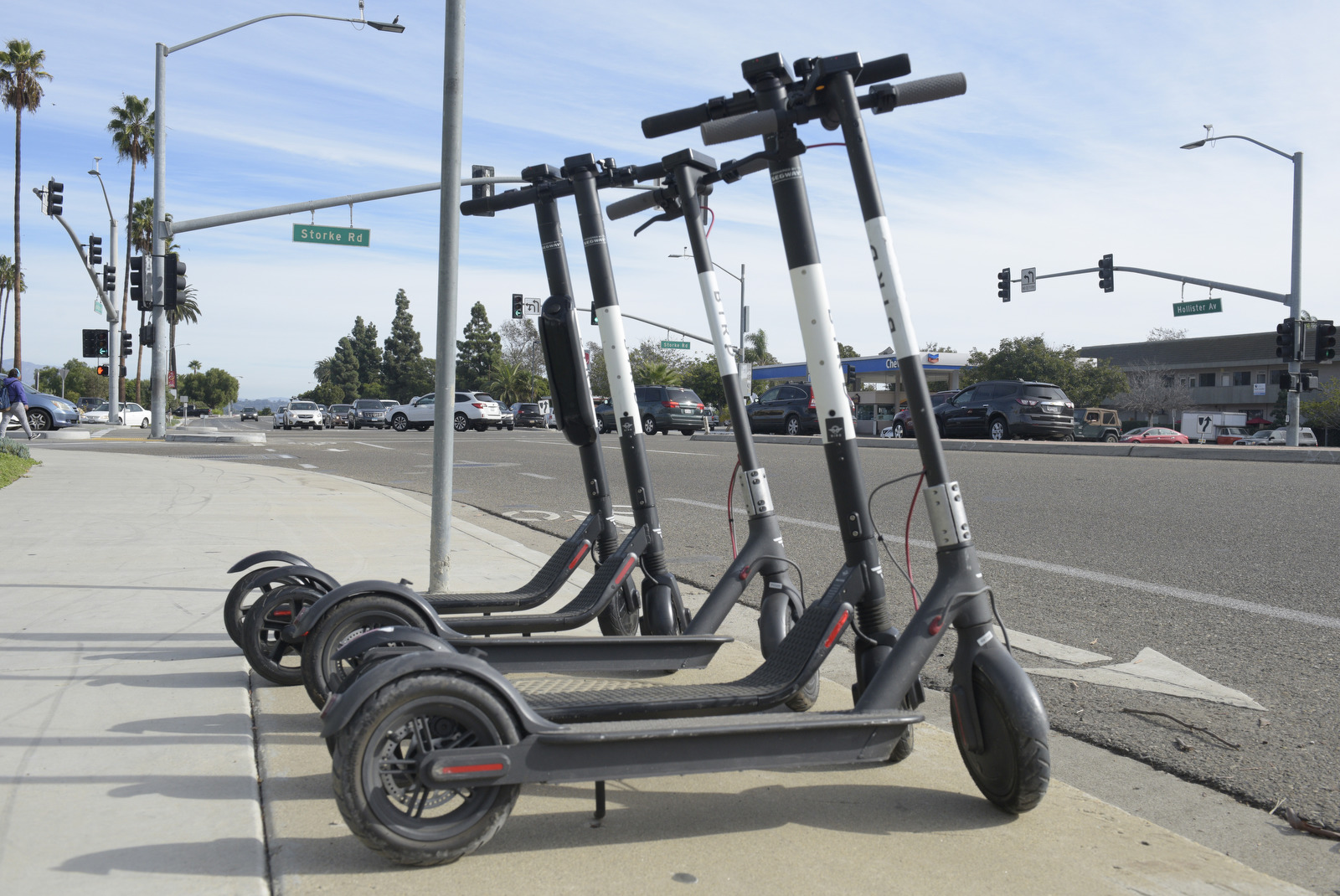Scooters Threaten Santa Barbara’s Civic Tranquility with Too Much Fun
A Fad, a Craze, or the Future?

Some mornings when you awake, the silliness has already been slapped out of you. The snot too. On such days, a brief but violent break with monotony is called for, such as a quick ride on one of those electric scooters: those same e-scooters that now have Santa Barbara’s Blue Hair Establishment in such a mad scramble. And for good reason. The problem with e-scooters, it turns out, is pretty much everything. An even bigger problem is that they’re too much fun.
They’re quick (15 mph), they’re easy, and, for a few brief moments, they put the sun in your face and the wind at your back. You want to laugh for no reason at all. Better yet, they require no massive investments in ossified transport systems or infrastructure. Compared to street drugs, electric scooters are a bargain, do not induce constipation, and are not known to be addictive. On top of all that, they can, on occasion, serve a genuinely practical function. They get you from Point A to Point B.
The downside is that they’re obnoxious.
This Tuesday, the Santa Barbara City Council tried to wrap its arms around the e-scooter phenomenon. The industry reps who dressed up for the occasion were told they’re not ready for prime time yet; come back when you grow up. City mobility czar Rob Dayton, an alt-transportation John the Baptist, helpfully suggested safety improvements such as a wider base, bigger wheels, better suspension and brakes, turn signals, and state-of-the-art GPS capacity that will automatically shut the power off on any scooters that set foot on city sidewalks. The day before, the Carpinteria City Council took a unilateral preemptive strike, banning e-scooters well before they ever showed up. And who can forget the state of emergency declared by the City of Goleta earlier this year in the face of electric scooters piling up on Good Land sidewalks and right-of-ways. Goleta and UCSB, it should be acknowledged, have been victimized by the new municipal malady, “scooter drift.” That’s when scooter-addled students from Isla Vista ride into your space — “scooting while intoxicated” — toss their ride onto the concrete blocking the path of an oncoming wheelchair, and then forget where they left it. It should be remembered, of course, Goleta once tried to ban the visual blight of backyard clotheslines.
For people concerned about the rational functioning of municipal government, electric scooters — “scoo-share” as they’re unfortunately known — rank up there with jellyfish infestations and homeless people screaming at God. They take over sidewalks. They are dumped hither and thither, like so many smelly socks. Someone might get hurt. In fact, epidemiological studies indicate riders fall off at alarming rates due to bumpy roads, crappy design, poor manufacture quality, and zero maintenance.
I was inside City Hall this summer when Lime dumped a few hundred scooters on the streets of Santa Barbara despite being expressly told not to. Phones were ringing off the hook. You’d have thought Trump’s phantom invading immigrant hordes were roaming State Street. For a minute, I thought something exciting had happened.
Santa Barbara is, as always, sending massively mixed messages to and about the scooter industry. The County of Santa Barbara, for example, just welcomed scooters with arms flung open wide. And the Santa Barbara County Association of Government (SBCAG) — which represents the Pork & Public Works Departments of the county and every single city in Santa Barbara County — is hosting a Scooter Summit Thursday, February 28, at Faulkner Gallery. The idea here is not to straitjacket the industry into oblivion — outright bans are illegal because state vehicle code recognizes the right of scooters to exist — but to help shape it. Leading the charge for SBCAG is Kent Epperson, another alt-transit evangelist. New models will be on hand to test ride, industry representatives will be available to apologize to anyone for pretty much anything, and a micro-mobility czar from Santa Monica will explain how they harnessed the infernal scooter to get people out of their cars, reduce traffic congestion, and limit greenhouse gasses emanating from all of the above.
The really exciting fact about scooters is that they appeal to people who would never dream of riding a bike or taking the bus. Epperson says there’s evidence to indicate scooters function as gateway drugs; people who ride scooters first, he said, are more likely to try out bike sharing.
Can it work here? It would fun to find out. And there are worse things than that.



